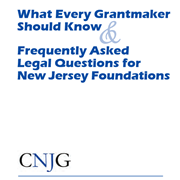Site Search
- resource provided by the Forum Network Knowledgebase.
Search Tip: Search with " " to find exact matches.
... New Jersey State Council on the Arts Webinar Video Resources Solidarity Not Charity: Arts & Culture Grantmaking ... Economy - Grantmakers in the Arts Solidarity Economy Resources - Grantmakers in the Arts Grants to Worker ...
Event Type: Affinity Group Meeting
Audience: All Funders
Funding Area: Arts/Culture/Humanities
Publication Date: December, 2010

This guide was designed to help the state’s philanthropic community understand their ethical, legal, and fiduciary requirements and obligations.
Resource Type: CNJG Documents/ReportsResource Guide
Audience: All Funders
Topic: Governance
... and promote effective philanthropy throughout New Jersey. CNJG’s programs and resources increase the impact of organized philanthropy’s ...
News Type: CNJG News
Publication Date: April, 2014
... C. Fox Foundation, have joined together to bring new resources to the field of philanthropy focused on engaging ... for engaging youth in philanthropy. Throughout both resources, the voices of next gen donors describe what works ...
Resource Type: Issue Briefing
Audience: Family Foundation
Topic: Governance
Publication Date: January, 2018
... employees, and volunteers in the event of a lawsuit. CNJG offers its members the D&O liability insurance program ... is available to foundations with current membership with CNJG. Fiduciary Liability and other coverage is also ... foundations should let Aon know they are a member of CNJG, a member of the United Philanthropy Forum. D&O ...
... President and CEO, Princeton Area Community Foundation, CNJG Board Chair from 2021 to 2023, and Board Trustee from ... through the pandemic years, a leadership transition, and strategic planning process. His legacy of leadership includes the 2023 - 2025 Strategic Plan, the creation of a Racial Equity Taskforce, now a ...
Publication Date: April, 2013
Resource Type: Report
Audience: All FundersNon Profit Staff
Topic: Strategy & Collaboration
... reads.” This has been an “occasional series” of CNJG eNews during the summer, over the years. In addition to ... expand our definition of philanthropy as guided by our Strategic Plan . Chanika Svetvilas, Manager of Programs and Learning ...
... including the recently released Ten Point Literacy Plan . We will hone in on statewide and local data with the ... and CEO, United Way of Greater Newark Cost : Free for CNJG Members; $50 for Non Member Grantmakers. Newark ...
Event Type: Affinity Group Meeting
Audience: All Funders
Funding Area: EducationalNewark Funders
... Foundation (6/16/2020) Creative New Jersey: Summary and resources from their statewide conversation on Racial Justice ... Communications Network: Crowdsourced Anti-Racism Resources and Tools NonprofitAF.com: Privilege, power, and ... Philanthropy Network Greater Philadelphia: Articles and Resources from the webinar: The Crisis of White Supremacy in ...
Publication Date: August, 2013
Philanthropic organizations of all shapes and sizes are well positioned to support Communities for a Lifetime (CfaL). This issue brief explores four roles for philanthropy in advancing CfaL work.
Resource Type: Issue Briefing
Audience: Community Foundation
Funding Area: Seniors/Aging
Publication Date: March, 2024
Alexis Bivens, Vice President of Strategic Initiatives and Managing Director of the Supporting ...
Resource Type: Presentation
Audience: All Funders
Topic: Strategy & Collaboration
... Palace at Somerset Park 333 Davidson Ave, Somerset, NJ CNJG’s 2025 Conference for the Social Sector— Stronger ... impact the social sector by buttressing these connections. CNJG represents over 130 of NJ’s leading philanthropic ...
Event Type: Signature Events
Audience: All Funders
The 4 th goal of CNJG’s strategic plan calls for CNJG to expand partnerships and collaborations to create more ...
... Community in Partnership Rosalía Velázquez , Director of Strategic Partnerships, New Jersey Center of Nonprofits ...
Publication Date: February, 2012
Resource Type: Report
Audience: All FundersNon Profit Staff
Topic: Strategy & Collaboration
... All New Jersey-based nonprofits, including all members of CNJG and the New Jersey Center for Nonprofits , receive ... watch the recording here . Sponsor Acknowledgement CNJG and the New Jersey Center for Nonprofits sincerely thank ... your New Jersey-based community of practice for funders! CNJG supports the philanthropic sector through shared ...
... and networking events for the social sector in the state, CNJG’s 2021 Virtual Spring Conference considered the role ...
Event Type: Signature Events
Joint Statement from CNJG and the Center for Non-Profits This statement also ... the best that we know our country is. Maria Vizcarrondo CNJG CEO and President Linda Czipo Center for Non-Profits CEO and President William V. Engel CNJG Board Chair Gina M. Plotino Center for Non-Profits Board ...
News Type: CNJG News
... can collaborate and increase their impact. You can find resources from the event, including workshop slides, on the ... the board. Jeff served as board chair during the pandemic, strategic planning, and leadership transitions. Thank you, ... organizational tasks include working with the new CNJG board chair to review committee membership and invite ...
